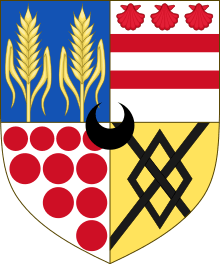Ralph Bigland (born 1757)
Sir Ralph Bigland (né Owen; 1 May 1757 – 14 July 1838) was an English herald. He was the son of Joseph Owen of Salford, Lancashire, and Elizabeth-Maria Owen (née Bigland).
In 1774, he received royal licence to take the surname and arms of Bigland.[1] He did this out of respect to his maternal uncle, Ralph Bigland,[2] English Officer of Arms, at his uncle's desire.[3] That same year he became Rouge Dragon Pursuivant,[4] the first of five heraldic appointments he was to hold in the College of Arms.
Like his uncle, he rose to the most senior office, being appointed Garter Principal King of Arms from 1831[5] (the same year he was created Knight Bachelor[6]) until his death. He was the last to hold all three Kingships of the College of Arms in succession.[3]
Arms
 |
|
References
- "Tables: January to December 1774 : British History Online". British History Online. University of London. 1899. Retrieved 2015-12-14.
Owen, Ralph Bigland, to take surname and arms of Bigland. 21 [Oct]
- Edward Cave; John Nichols (1838). The Gentleman's Magazine, and Historical Chronicle, for the Year ... Edw. Cave, 1736-[1868]. pp. 226–234.CS1 maint: extra punctuation (link)
- Walter H. Godfrey; Sir Anthony Wagner; H. Stanford London (1963). The College of Arms. p. 65.
- Mark Noble (1804). A history of the College of Arms: and the lives of all the Kings, Heralds, and Pursuivants from the reign of Richard III, founder of the College, until the present time. Printed for J. Debrett and T. Egerton. p. 442. Retrieved 14 December 2015.
- "No. 18876". The London Gazette. 22 November 1831. p. 2424.
- "No. 18882". The London Gazette. 9 December 1831. p. 2572.
- Godfrey, Walter H; Wagner, Anthony (1963). "'Garter King of Arms', in Survey of London Monograph 16, College of Arms, Queen Victoria Street (London, 1963), pp. 38-74". british-history.ac.uk. Retrieved 2018-11-01.
| Heraldic offices | ||
|---|---|---|
| Preceded by Thomas Locke |
1774–1780 |
Succeeded by Benjamin Pingo |
| Preceded by Peter Dore |
1780–1803 |
Succeeded by Joseph Hawker |
| Preceded by George Harrison |
1803–1822 |
Succeeded by Edmund Lodge |
| Preceded by Sir George Nayler |
1822–1831 |
Succeeded by Sir William Woods |
| Preceded by Sir George Nayler |
1831–1838 |
Succeeded by Sir William Woods |